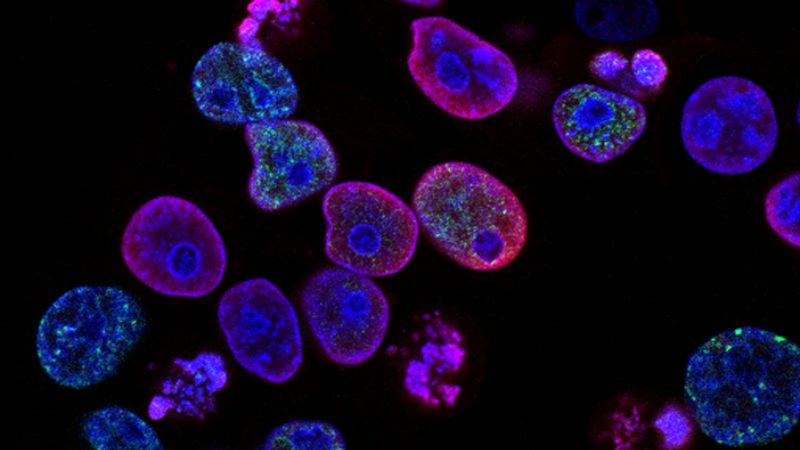The 2025 Emerging Leader in Molecular Spectroscopy: Lingyan Shi of the University of California, San Diego

The 2025 Emerging Leader in Molecular Spectroscopy: Lingyan Shi
Lingyan Shi is an Associate Professor (tenured) in the Department of Bioengineering at the University of California, San Diego (La Jolla, CA). Shi is a researcher in biomedical imaging whose work involves developing and applying molecular imaging techniques to study metabolic activity in biological tissues. Her research integrates methods such as stimulated Raman scattering (SRS), multiphoton fluorescence (MPF), fluorescence lifetime imaging (FLIM), and second harmonic generation (SHG) microscopy into a combined imaging platform capable of chemical-specific and high-resolution imaging in situ.
Shi’s work includes the identification of an optical window favorable for deep-tissue imaging, referred to as the “Golden Window,” and the development of metabolic imaging approaches using deuterium-labeled compounds. These approaches allow detection of newly synthesized macromolecules—such as lipids, proteins, and DNA—through their carbon-deuterium vibrational signatures using SRS. She has also contributed to data processing methods for imaging, including spectral unmixing and image reconstruction algorithms like Adam optimization-based Pointillism Deconvolution (A-PoD) and penalized reference matching for SRS (PRM-SRS).
At the University of California, San Diego, Shi’s lab continues to adapt SRS microscopy for use in various biological and biomedical contexts. The imaging systems and computational tools developed in her lab are used to study cellular and tissue-level processes related to disease progression, therapeutic response, and metabolic regulation.
Shi earned a Ph.D. in Biomedical Engineering from the City College of New York (CCNY) in 2014. She completed postdoctoral research in biophotonics at the Institute for Ultrafast Spectroscopy and Lasers at CCNY, received training in advanced imaging at the Max Planck Institute for Neuroscience, and conducted postdoctoral work in chemistry at Columbia University from 2016 to 2019.
She is the winner of the 2025 Emerging Leader in Molecular Spectroscopy Award, which will be presented to her at the SciX 2025 Conference, taking place from October 5-10 at the Northern Kentucky Convention Center in Covington, Kentucky.
Spectroscopy’s Emerging Leader in Molecular Spectroscopy Award recognizes the achievements and aspirations of a talented young molecular spectroscopist who has made strides early in their career toward the advancement of molecular spectroscopy techniques and applications. The award is given to a researcher who has focused the majority of their work in the field of vibrational or electronic spectroscopy, with direct contributions to Raman, infrared, near-infrared, terahertz, fluorescence, and/or UV-vis spectroscopy through original research on the development or advancement of theory, instrumentation, measurement techniques, or applications.
Key Contributions
Over the course of her academic career, Shi has built a publication record that reflects steady contributions to the field of biomedical imaging and molecular spectroscopy. Her work has been cited a total of 3,829 times, according to Google Scholar. She holds an h-index of 33, indicating that 33 of her publications have each received at least 33 citations, and an i10-index of 61, marking 61 papers with at least ten citations each. These figures suggest sustained engagement with her research across multiple areas of biophotonics and chemical imaging.
Shi’s publications appear in a range of peer-reviewed journals spanning optics, chemistry, biomedical engineering, and analytical science. Her work has been published in Nature Communications, Science Advances, ACS Nano, Nano Letters, Proceedings of the National Academy of Sciences (PNAS), Analytical Chemistry, Journal of Biomedical Optics, Biophysical Journal, Journal of the American Chemical Society (JACS), and Light: Science & Applications, among others. These venues reflect the interdisciplinary nature of her research, which intersects imaging technology, metabolic analysis, and molecular diagnostics.
In addition to publishing, Shi has been invited to present her work in a wide variety of academic and professional settings. She has delivered 115 invited talks, sharing findings and methods related to multimodal imaging platforms, vibrational spectroscopy, and metabolic pathway visualization in contexts ranging from basic research to applied biomedical studies.
Most Notable Research
Over the course of her career, Shi has contributed several notable peer-reviewed articles that reflect her interdisciplinary expertise in biophotonics, vibrational spectroscopy, and metabolic imaging.
“Since she started her independent position at University of California, San Diego in 2019, she has further developed the imaging technique to the next generation and used it to obtain biological insights of important problems,” said Wei Min, professor of Chemistry at Columbia University and Shi’s postdoctoral advisor. “She is clearly one of the strongest young scientists working on vibrational imaging.”
One of Shi’s most recent co-authored studies, published in Cell Metabolism, investigates how neuronal AMP-activated protein kinase (AMPK) influences microglial lipid droplet accumulation in the context of tauopathy. This work integrates molecular neuroscience with lipid metabolism and highlights Shi’s contributions to imaging brain metabolic changes in neurodegenerative disease models (1).
In Nature Communications, Shi and collaborators introduced hyperspectral penalized reference matching stimulated Raman scattering (PRM-SRS) microscopy, an advanced imaging platform capable of distinguishing multiple molecular species simultaneously. This work represents a technical leap in the field of multiplex imaging (2).
Another publication in Nature Methods demonstrates the use of A-POD (Adam optimization-based pointillism deconvolution) for super-resolution SRS microscopy. The approach enhances spatial resolution and chemical specificity, supporting non-invasive imaging at the nanoscale in live cells and tissues (3).
A recent article in Nature Communications applies label-free multimodal optical biopsy to diabetic kidney tissue. Shi’s work here reveals both biochemical and structural tissue changes in 2D and 3D, showcasing the diagnostic potential of multimodal vibrational imaging (4).
In Aging Cell, Shi and her team used deuterium oxide–stimulated Raman scattering (DO-SRS) to study metabolic shifts in Drosophila during aging, illustrating the value of non-destructive imaging tools in model organism studies (5).
Complementing this, a 2023 article in GEN Biotechnology describes how bioorthogonal SRS techniques uncovered dynamic changes in lipid metabolism in aging brain tissue, offering mechanistic insights into age-related lipid regulation (6).
An earlier foundational study, published in Journal of Biophotonics, characterized transmission efficiency in the near-infrared “optical windows” for deep brain imaging. This work identified what Shi termed the “Golden Window” for optical penetration depth—now widely referenced in tissue imaging (7).
In a 2018 Nature Communications article, Shi and collaborators applied optical metabolic imaging to visualize in vivo biochemical processes, paving the way for systems-level understanding of metabolic flux in whole organisms (8).
As co-first author on a Nature Biomedical Engineering study, Shi contributed to the development of deuterium isotope-based imaging for tracking glucose metabolism in vivo, allowing for high-resolution metabolic pathway visualization (9).
In another article in Nature Methods, she co-developed a mid-infrared metabolic imaging technique using vibrational probes, enabling label-free analysis of metabolic changes in tissues and live animals (10).
“As an independent researcher, Prof. Shi has further expanded the reach of D2O-based labeling combined with SRS mapping, or DO-SRS for short,” said Eric Olaf Potma, professor of Chemistry at the University of California Irvine. “I expect that many high impact studies will follow from the work she has published, and that many researchers will follow her lead in applying DO-SRS to their own biomedical imaging studies.”
Key Awards and Honors
Throughout her career, Shi has received several awards and recognitions from universities and scientific societies. In 2025, she was named a senior member of the National Academy of Inventors and received the Emerging Leader in Molecular Spectroscopy Award from FACSS SciX. That same year, she was featured in the Optics notebook commemorating the 20th anniversary of SPIE and received the Med-X Young Investigator Award from Springer Nature. In late 2024, Shi was honored with the IUPS Young Faculty Award from the International Union of Physiological Sciences and the Rising Star Award at the International Conference on Biomedical Engineering (ICBME). She was also recognized as a Young Scientist at the Davos Summit’s iCANX Awards.
Shi has served as a speaker at the China-America Frontiers of Engineering symposium held by the National Academy of Engineering. Earlier, she earned the BMES-CMBE Rising Star Young Faculty Award, the BIOS Hitachi High-Tech Best Presentation Award at SPIE Photonics West, and the David L. Williams Lecture and Scholarship Award at the Kern Lipid Conference. In 2023, she was named a Sloan Research Fellow in Chemistry and an Advanced Imaging Scialog Fellow supported by the RCSA and the Chan Zuckerberg Initiative.
Other honors include the LOPS Golden Talk Award, a Faculty Fellowship in Israel, and multiple recognitions as a Scialog Fellow. Shi was designated a senior member of The Optical Society (OSA) in 2020. Earlier awards include the Blavatnik Regional Award for Young Scientists from the New York Academy of Sciences, the Rising Star Award from Nature Light in 2021, and the Rising Star Award from Laser Focus World. Additionally, she received the Hellman Fellowship and was recognized for outreach and academic service during her time at City College of New York. Shi is also a member of the Tau Beta Pi National Engineering Honor Society.
Service to the Scientific Community
Shi has been actively engaged in the broader scientific community through extensive peer review and editorial service, complementing her research contributions. She serves as a reviewer for a wide range of high-impact journals across disciplines in biology, chemistry, optics, and biomedical engineering. Among the journals she has reviewed for are Cell, Nature Methods, Nature Communications, Science Advances, Light: Science & Applications, GEN Biotechnology, Cell Reports, Physics Reports, and eLight. Her reviewer responsibilities extend to Advanced Healthcare Materials, International Journal of Molecular Sciences, Scientific Reports, Optics and Lasers in Engineering, Journal of the Royal Society Interface, Nano Letters, ACS Nano, and Annals of Biomedical Engineering, among others.
She also provides peer review for specialized and interdisciplinary journals such as Biomacromolecules, Expert Opinion on Drug Discovery, Journal of Bioscience and Bioengineering, Pharmaceutics, Theranostics, Journal of Biomedical Optics, Biomedical Optics Express, Journal of Biophotonics, and Frontiers in Biophotonics. Her review portfolio includes contributions to Cellular and Molecular Bioengineering (CAMB), ACS Chemical Neuroscience, Journal of Oncology, Optics Express, WIREs Mechanisms of Disease, Journal of Innovative Optical Health Sciences, Journal of Modern Optics, Nanomedicine: Nanotechnology, Biology, and Medicine, Analytical Chemistry, Chemical & Biomedical Imaging, Advanced Imaging, and iScience.
In addition to her role as a reviewer, Shi contributes editorial leadership in her field. She is an associate editor of npj Imaging (a Nature Portfolio journal), and a review editor for Frontiers in Physiology and Frontiers in Biophotonics. She has also served as a guest editor for special issues including Journal of Innovative Optical Health Sciences (focused on the polarization of light in biomedical applications), Biomedical Photonics Advances (MDPI Photonics), and Technology and Applications of Biomedical Optics (MDPI Photonics).
Shi is an active member of numerous professional societies that reflect her interdisciplinary interests and collaborations. Her memberships include Optica (formerly The Optical Society), the International Society for Optics and Photonics (SPIE), the Biomedical Engineering Society (BMES), the Institute of Electrical and Electronics Engineers (IEEE), the American Physical Society (APS), the World Molecular Imaging Society (WMIS), the American Association for Cancer Research (AACR), the American Society for Cell Biology (ASCB), the New York Academy of Sciences (NYAS), the American Society of Mechanical Engineers (ASME), and the Society for Neuroscience (SfN). She is also affiliated with the Coblentz Society, the International Union of Physiological Sciences (IUPS), the American Chemical Society (ACS), and the National Academy of Inventors (NAI).
Bright Future
Shi is rapidly establishing herself as a leading innovator in vibrational imaging, with a research trajectory poised to transform biomedical microscopy and molecular spectroscopy. Since starting her independent lab at University of California, San Diego in 2019, Shi has significantly advanced SRS microscopy, a rapidly advancing technique that uniquely images molecular vibrations to reveal chemical information in biological samples.
Her work is focused on solving two enduring challenges in SRS: improving spatial resolution and enhancing spectral specificity.
“Lingyan’s independent work at University of California, San Diego has taken the technology and application of SRS to the next level. In particular, she is working on solving two long-standing challenges: spatial resolution and spectral specificity,” Min said, “Her team demonstrated a spatial resolution of 52 nm, which is a record in the chemical imaging field.”
This milestone sets a new benchmark for nanoscale chemical imaging, enabling researchers to visualize biological structures with unprecedented clarity.
Shi’s innovations extend beyond theory to practical implementation. Potma highlights her development of the Adam-based pointillism deconvolution (A-Pod) algorithm, which improves super-resolution SRS imaging. “Although several SRS superresolution techniques have been developed by others, none of them are really practical,” he said, “I suspect that A-Pod may change that. As an algorithmic approach, it is relatively easy to implement, and importantly, it is extremely fast compared to competing deconvolution techniques. Superresolution SRS has never been this easy, thanks to Prof. Shi!”
By marrying scientific creativity with pragmatic solutions, Shi is uniquely positioned to become a future leader in molecular spectroscopy and biomedical imaging, with a broad impact across multiple spectroscopy-related disciplines.
References
(1) Li, Y.; Munoz-Mayorga, D.; Nie, Y.; Kang, N.; Tao, Y.; Lagerwall, J.; Pernaci, C.; Curtin, G.; Coufal, N. G.; Mertens, J.; Shi, L.; Chen, X. Microglial Lipid Droplet Accumulation in Tauopathy Brain is Regulated by Neuronal AMPK. Cell Metab. 2024, 36(6), 1351–1370. DOI: 10.1016/j.cmet.2024.03.014
(2) Zhang, W.+; Li, Y.+; Fung, A. A.+; Li, Z.; Jang, H.; Zha, H.; Chen, X.; Gao, F.; Wu, J. Y.; Sheng, H.; Yao, J.; Skowronska-Krawczyk, D.; Jain, S.; Shi, L. Multi-Molecular Hyperspectral PRM-SRS Microscopy. Nat. Commun. 2024, 15, 1599. DOI: 10.1038/s41467-024-45576-6
(3) Jang, H.; Li, Y.; Fung, A. A.; Bagheri, P.; Hoang, K.; Skowronska-Krawczyk, D.; Chen, X.; Wu, J. Y.; Bintu, B.; Shi, L. Super-Resolution Stimulated Raman Scattering (SRS) Microscopy Using A-POD. Nat. Methods 2023, DOI: 10.1038/s41592-023-01779-1.
(4) Fung, A. A.; Li, Z.; Boote, C.; Markov, P.; Jain, S.; Shi, L. Label-Free Multimodal Optical Biopsy Reveals Biomolecular and Morphological Features of Diabetic Kidney Tissue in 2D and 3D. Nat. Commun. 2025, DOI: 10.1038/s41467-025-59163-w
(5) Li, Y.; Zhang, W.; Fung, A. A.; Shi, L. DO-SRS Imaging of Diet Regulated Metabolic Activities in Drosophila During Aging Processes. Aging Cell 2022, 21(4), e13586. DOI: 10.1111/acel.13586
(6) Li, Y.; Chang, P.; Sankaran, S.; Jang, H.; Nie, Y.; Zeng, A.; Hussain, S.; Wu, J. Y.; Chen, X.; Shi, L. Bioorthogonal Stimulated Raman Scattering Imaging Uncovers Lipid Metabolic Dynamics in Brain During Aging. GEN Biotechnol. 2023, DOI: 10.1089/genbio.2023.0017
(7) Shi, L.; Sordillo, L.; Rodríguez-Contreras, A.; Alfano, R. R. Transmission in Near-Infrared Optical Windows for Deep Brain Imaging. J. Biophotonics 2016, 9 (1–2), 38–43. DOI: 10.1002/jbio.201500192
(8) Shi, L.; Zheng, C.; Shen, Y.; Chen, Z.; Silveira, E.; Zhang, L.; Chang, L.; De Sena Tomas, C.; Targoff, K.; Min, W. Optical Imaging of Metabolic Dynamics in Animals. Nat. Commun. 2018, 9(1), 2995. DOI: 10.1038/s41467-018-05401-3
(9) Zhang, L.; Shi, L.; Shen, Y.*; Min, W. Spectral Tracing of Isotope Deuterium for Imaging Glucose Metabolism. Nat. Biomed. Eng. 2019, 3(5), 402–413. DOI: 10.1038/s41551-019-0393-4
(10) Shi, L.; Liu, X.; Shi, L.; Stinson, H.; Rowlette, J.; Kahl, L.; Evans, C.; Zheng, C.; Dietrich, L.; Min, W. Mid-Infrared Metabolic Imaging with Vibrational Probes. Nat. Methods 2020, 17(8), 844–851. DOI: 10.1038/s41592-020-0883-z
(Note: ‘+’ indicates equal contribution; ‘‘ indicates co-first authorship; ‘**’ indicates co-corresponding authorship, as cited in original sources.*)





